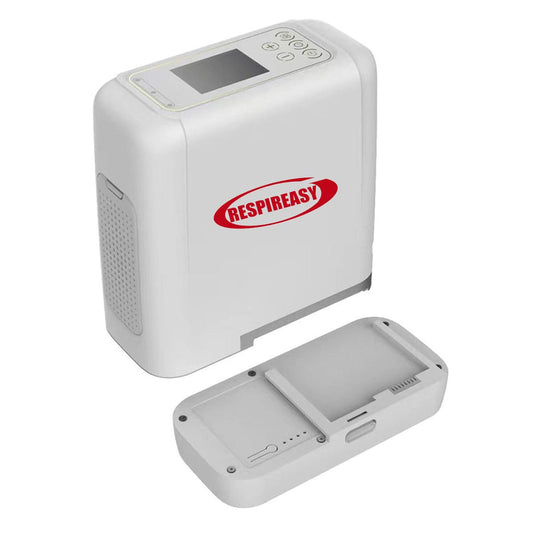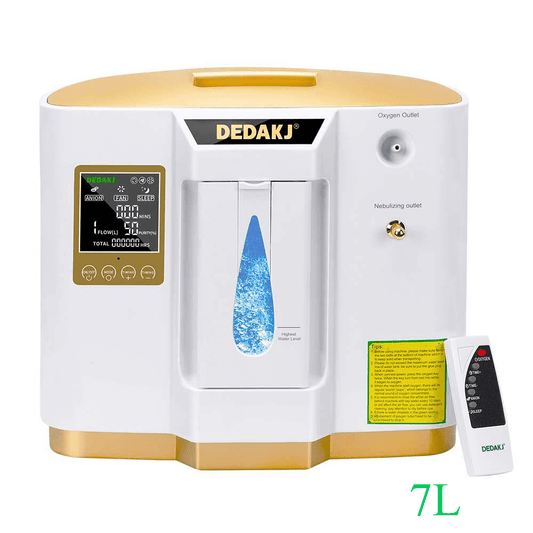Precauciones al utilizar el concentrador de oxígeno en el hogar
La inhalación de oxígeno puede aliviar la fatiga y reducir el estrés, pero si no sigue el consejo del médico e inhala oxígeno a ciegas sin límite, la "terapia de oxígeno" de alta concentración puede causar complicaciones, que inhibirán la respiración, causarán intoxicación por oxígeno, malestar y dolor detrás del esternón, agravarán al inhalar, tos, disnea, etc., lo cual no es bueno.
Además, el cuerpo humano no puede almacenar oxígeno y la capacidad de la hemoglobina humana para transportarlo también es limitada. Por lo tanto, la inhalación de oxígeno no puede aumentar el oxígeno de la sangre arterial ni mejorar la producción de oxígeno del cerebro. El oxígeno solo puede actuar como un placebo. No hay evidencia confiable que demuestre que la inhalación de oxígeno tenga un efecto muy obvio en el cuidado de la salud. Debe enfatizarse que la inhalación de oxígeno no puede mejorar la inteligencia. Es solo una "ayuda de combustible" en el metabolismo oxidativo del azúcar nutriente. El cerebro es el órgano con mayor consumo de oxígeno en el cuerpo. Durante el trabajo mental intenso, la cantidad de oxígeno cerebral aumentará, pero es muy limitada. Puede satisfacerse aumentando la sangre a través de la autorregulación.
La inhalación de oxígeno también requiere algunas precauciones, como los siguientes puntos: ☟☟
1. El caudal de oxígeno para fines sanitarios no debe ser superior a 3 litros/minuto y el tiempo total de uso por día no debe superar 1 hora. El suministro de oxígeno de alta concentración no debe utilizarse durante demasiado tiempo. En general, se cree que si la concentración de oxígeno es >60% y dura más de 24 horas, puede producirse una intoxicación por oxígeno. En caso de insuficiencia respiratoria aguda, como insuficiencia respiratoria, síndrome de dificultad respiratoria aguda, intoxicación aguda (como intoxicación por monóxido de carbono, es decir, intoxicación por gas), depresión respiratoria, etc., se debe utilizar oxígeno puro o de alta concentración para el rescate cada segundo, pero no debe utilizarse durante mucho tiempo para evitar la intoxicación por oxígeno u otras complicaciones. En circunstancias normales, nuestros pulmones mantienen un equilibrio con la presión atmosférica externa llenándose de nitrógeno que es difícil de absorber por los pulmones bajo presión normal. Al inhalar aire con alto contenido de oxígeno, el contenido de nitrógeno en los alvéolos disminuye gradualmente y el oxígeno puede ser absorbido por los alvéolos, lo que da como resultado una disminución de la presión alveolar interna y causa atelectasia.
2. La administración de oxígeno en alta concentración a pacientes con exacerbación aguda de enfermedad pulmonar obstructiva crónica puede causar depresión respiratoria y empeorar la afección. En general, se debe administrar oxígeno controlado (es decir, continuo a baja concentración). Cuando la insuficiencia respiratoria crónica pierde la compensación, la inhalación de oxígeno debe tener en cuenta el aumento de la presión parcial de oxígeno en sangre. Una presión parcial de oxígeno en sangre demasiado alta puede debilitar la estimulación refleja del seno carotídeo hacia el centro respiratorio, lo que reduce la ventilación y agrava la retención de dióxido de carbono. Por lo tanto, utilice el oxígeno con precaución.
3. Prevenir la contaminación y el bloqueo del catéter. La congestión nasal, el catéter de suministro de oxígeno, el dispositivo de humidificación y calefacción, el sistema de tuberías del ventilador, etc. deben reemplazarse, limpiarse y desinfectarse regularmente para prevenir la infección cruzada. Los catéteres de inhalación de oxígeno y la congestión nasal deben revisarse en cualquier momento para detectar obstrucciones por secreciones y reemplazarse a tiempo. Para garantizar una terapia de oxígeno efectiva y segura.
4. Prestar atención a la calefacción y humidificación durante la oxigenoterapia. Mantener una temperatura de 37°C y una humedad del 95% al 100% en las vías respiratorias es una condición necesaria para la función de depuración normal del sistema mucociliar en la tráquea. Por lo tanto, la inhalación de oxígeno debe realizarse a través de una botella humidificadora y los dispositivos de calefacción necesarios para evitar que la inhalación de oxígeno seco y frío estimule y dañe la mucosa de las vías respiratorias, causando sequedad del esputo y afectando la función "depuradora" de los cilios.
En resumen, al inhalar oxígeno, se debe tener en cuenta que el uso inadecuado del mismo también tiene efectos secundarios, especialmente para los pacientes. Debe utilizarse bajo la supervisión de un médico. En circunstancias normales, las personas sanas generalmente no sufren hipoxia y el oxígeno entregado a los tejidos humanos siempre supera el consumo de oxígeno de los tejidos. La atmósfera contiene aproximadamente un 20% de oxígeno, que es un valor relativamente constante. La contaminación del aire solo aumenta algunas partículas de impurezas y no afecta la concentración de oxígeno en el aire. Incluso en áreas densamente pobladas, es suficiente para satisfacer las necesidades de las personas.



















































